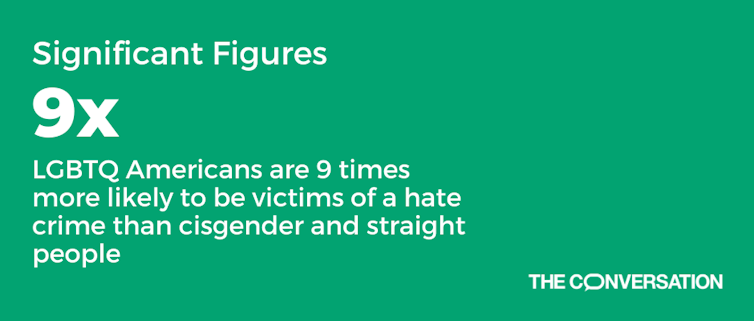by Andrew Ryan Flores, American University; Ilan Meyer, University of California, Los Angeles; and Rebecca Stotzer, University of Hawaii, [This article first appeared in The Conversation, republished with permission]

In our recent analysis of the National Crime Victimization Survey, we found that the odds of being a violent hate crime victim for LGBTQ people was nine times greater than it was for cisgender and straight people from 2017 to 2019.
There were an average annual 6.6 violent hate crime victimizations per 1,000 LGBTQ people during this three year period.
In contrast, there were 0.6 violent hate crime victimizations per 1,000 cisgender and straight people.
A hate crime is an attack or threat of an attack that’s motivated by the victim’s perceived race, ethnicity, sexuality, gender or religion. Or it could include someone’s association with any of the previous categories, such as an anti-Muslim hate crime committed against someone who is Sikh.
The National Crime Victimization Survey is a nationally representative survey that asks over 200,000 people about non-fatal crimes that happened to them in the past year. Since 1999, it has asked victims if they suspected their victimization was motivated by certain biases, and if so, the reason for the bias. We use the National Crime Victimization Survey classification of hate crimes, which is consistent with the Bureau of Justice Statistics classification: victimizations that involve hate language, hate symbols, or were confirmed by police to be a hate crime.
Since 2017, the National Crime Victimization Survey has been documenting sexual orientation and gender identity of respondents. This has allowed us to estimate the rate of hate crimes against LGBTQ people for the first time.
Physical and psychological repercussions
Another notable finding from our study suggested that violent hate crimes involving LGBTQ victims have unique characteristics .
Prior research has suggested that LGBTQ victims of hate crime frequently did not know the offender. In our analyses, 49% of violent hate crimes with LGBTQ victims involved an attacker who was a close friend, family member, partner or former partner.
We also found that LGBTQ victims of violent hate crimes were more likely to have physical and psychological symptoms as a result of the attack when compared with LGBTQ victims of violent crimes that were not hate crimes.
For example, LGBTQ victims of violent hate crimes were four times more likely to feel worried or anxious as a result of the incident than LGBTQ victims of non-hate violence. Despite this, we found that only about 1 in 3 LGBTQ victims of violent hate crimes sought professional help for their symptoms.
Hate crimes don’t just affect the victims
Our findings complement a series of studies relying on the National Crime Victimization Survey that showed that LGBTQ people are generally victims of crimes at higher rates than cisgender and straight people, with bisexual women having markedly higher victimization rates than lesbians, and transgender people having higher victimization rates than cisgender people.
Hate crimes do not just affect an individual – whole communities can be affected by hate. In what’s known as “collective trauma,” LGBTQ people often internalize the violence inflicted on other members of the community.
LGTBQ people are still recovering from the November 2022 mass shooting at Club Q, an LGBTQ bar in Colorado Springs. The accused shooter has been charged with 48 counts of hate-motivated violence.
Our findings allow us to more fully characterize the stories of LGBT victims – and the heightened danger they face across the country.
Lynn Langton contributed to this article.
Andrew Ryan Flores, Visiting Scholar at the Williams Institute and Assistant Professor of Government, American University; Ilan Meyer, Distinguished Senior Scholar of Public Policy, University of California, Los Angeles, and Rebecca Stotzer, Professor of Social Work, University of Hawaii
This article is republished from The Conversation under a Creative Commons license. Read the original article.
